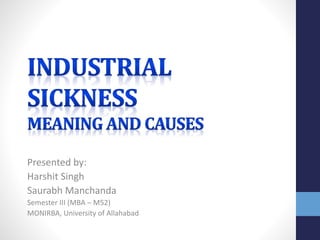
Industrial Sickness - Meaning and Causes
- 1. Presented by: Harshit Singh Saurabh Manchanda Semester III (MBA – M52) MONIRBA, University of Allahabad
- 2. Meaning • Industrial sickness usually refers to a situation when an industrial firm performs poorly, incurs losses for several years and often defaults in its debt repayment obligations. • A sick industrial unit may be defined as one when it fails to generate surplus on a continuous basis and depends on frequent infusion of external funds for its survival.
- 3. Meaning continued.. An industrial unit tends to show signs of financial distress starting with : Short term liquidity problems Revenue losses Operating losses Moving in the direction of over use of external credit.
- 4. Which type of units are sick ? To a Layman A sick unit is one which is not healthy. To an investor It is one which is not giving dividends. To a Banker It is a unit which has incurred cash losses in the previous years and is about to repeat the same performance in current and following years. To an Industrialist It is unit which is making losses and about to close.
- 5. According to Reserve Bank of India • A sick unit is that which has incurred a cash loss for one year and is likely to continue incurring losses for the current year as well as in the following year and • The unit has an imbalance in its financial structure. such as, current ratio is less than 1: 1 and there is worsening trend in debt-equity ratio
- 6. According to Companies Act, 2002 Sick Industrial Company means an industrial company which has i) The Accumulated losses in any financial year equal to 50 per cent or more of its average net worth during four years immediately preceding such financial year or ii) Failed to repay its debts within any three consecutive quarters on demand made in writing for its repayment by a creditor or creditors of such company.
- 7. According to the Development Commissioner, a small scale industrial unit (SSI) becomes sick if its: a) Capacity utilisation is less than 50 per cent of the highest achieved during the preceding five years , (b) Net worth has been eroded by more than 50 per cent; and (c) The unit has remained closed for a period more than six months
- 8. The Sick Industrial Companies Act 1985 identifies sickness in terms of cash losses for two consecutive financial years and accumulated losses equalling or exceeding the net worth of the second financial year. The State Bank of India has defined a sick unit as one “which fails to generate an internal surplus on a continuous basis and depends for its survival upon frequent infusion of funds.”
- 9. (1) Socio-economic problem: Industrial sickness is a serious socio-economic problem, which is result of unplanned industrial growth. It is a universal problem. (2) Outcome of various causes: Industrial sickness is the net result of variety of financial, technical, managerial, personnel and marketing causes faced by industrial units.
- 10. (3) Visible symptoms: Industrial sickness is visible by various symptoms such as financial difficulties, low profitability, inability to pay interest and loan instalments. (4) Serious consequences: The consequences of industrial sickness on employees, consumers, investors, management and the national economy are serious. In addition, banks and term lending institutions come in difficulties due to industrial sickness.
- 11. (5) Gradual process: Industrial sickness takes place in a gradual manner and not suddenly/overnight. Various stages are involved in this process. They include normal unit tending towards sickness, beginning of sickness and confirmed sickness with normal features. Preventive measures during incipient sickness are useful for avoiding sickness.
- 13. Sickness in industry can be classified into: (a) Genuine sickness which is beyond the control of the promoters of the concern despite the sincere efforts by them, (b) Incipient sickness due to basic non-viability of the project, and (c) Induced sickness which is due to the managerial incompetence and wrong policies pursued deliberately for want of genuine stake. This is a man-made sickness in which some unscrupulous promoters adopt fraudulent practices to start a concern and to get away with the money obtained by fraud and deceit.
- 14. Magnitude of Industrial Sickness • Industrial sickness is growing at an annual rate of about 28% & 13% respectively in terms of no .of units and outstanding number of bank credit. • It is estimated that as of today there are more then 2lakhs sick unit. With an outstanding bank credit of above Rs.7000crores. • Nearly 29000 units are added to sick list every year.
- 16. Causes of Industrial Sickness Internal Causes External Causes
- 17. 1. Technical feasibility: a) Inadequate Technical know-how b) Outdated production process 2. Economic viability: a) High cost of inputs b) Break even point too high c) Unduly large investment in fixed assets d) Under-estimation of financial requirements
- 18. Internal Causes 3. Production management: a) Poor capacity utilisation b) High wastage c) Inappropriate product-mix d) Inadequate maintenance and replacement 4. Labour management: a) Poor labour productivity b) Excessive manpower c) Lack of trained/skilled labour d) Excessively high wage structure
- 19. Internal Causes 5. Marketing management: a) Lack of market research and market feedback b) Defective pricing policy c) Dependence on limited number of customers 6. Financial management: a) Inadequate working capital b) Deficiency of funds
- 20. Internal Causes 7. Administrative management: a) Excessive expenditure on R & D b) Incompetent management c) Lack of timely diversification
- 21. 1. Infrastructural bottlenecks: a) Irregular supply of critical raw materials b) Transport bottlenecks c) Chronic power shortage 2. Government controls and policies: a) Government price controls b) Abrupt change in government policies c) Fiscal duties
- 22. External Causes 3. Market Constraints: a) Market saturation b) Revolutionary technological advances rendering one’s products obsolete 4. Extraneous factors: a) Natural calamities b) Political situation c) Sympathetic strikes
